The Birthstone for May 6: An In-Depth Exploration
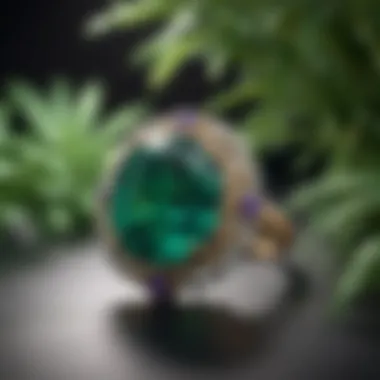
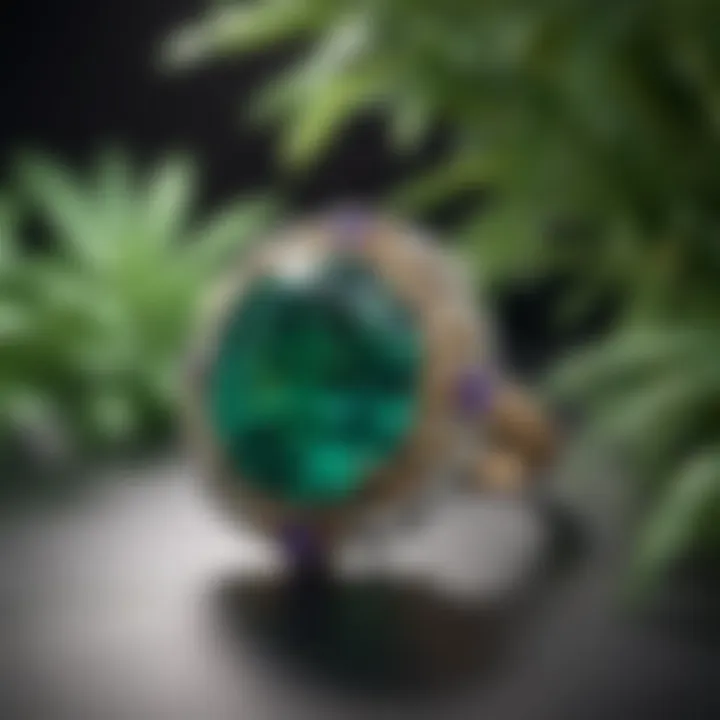
Intro
The exploration of birthstones provides a fascinating glimpse into the intersection of natural beauty and human culture. Each month is associated with a specific gemstone, and for those born on May 6, it is no different. Understanding the significance of a birthstone involves looking at its historical context, scientific properties, and its implications in contemporary society. This article will focus on the birthstone for May 6, delving into its characteristics, meaning, and practical advice for enthusiasts and collectors alike.
Gemstone Overview
Definition of Gemstones
Gemstones are naturally occurring minerals or organic materials that have been cut and polished for use in jewelry or decorative items. Their value often derives from their rarity, beauty, and durability. In the realm of gemstones, a few key aspects define them:
- Rarity: Not all stones are found in abundance. Some are limited to specific geographic locations.
- Aesthetics: The visual appeal of gemstones, including their color, cut, and clarity, plays a significant role in their desirability.
- Durability: Certain stones can withstand wear and tear better than others, affecting their usability in everyday jewelry.
Classification of Gemstones
Gemstones can be classified into two main categories: precious and semi-precious stones. Precious stones typically include diamonds, rubies, sapphires, and emeralds. These are known for their superior quality and demand. Semi-precious stones encompass a broader range and include amethyst, aquamarine, and garnet.
Some gemstones are further classified based on their chemical composition or crystallography. For example:
- Silicate minerals: Like quartz and tourmaline.
- Carbonate minerals: Such as calcite and malachite.
Understanding these classifications helps enthusiasts and collectors appreciate the diversity of gemstones available in the market.
Historical Significance
Origins of Gemstone Use
The use of gemstones dates back to ancient civilizations. Early humans likely valued gemstones for their beauty, but they also attributed various meanings and powers to them. In ancient Egypt, turquoise was revered for its protective properties. The Romans and Greeks similarly believed gemstones could provide physical and spiritual benefits.
Cultural Insights: Gemstones in Ancient Civilizations
Different cultures attribute various meanings to gemstones. The ancient Egyptians valued lapis lazuli for its deep blue color, associating it with the heavens and the afterlife. In India, rubies symbolized love and passion. Over time, many civilizations incorporated gemstones into their rituals and practices, displaying them in crowns, amulets, and ceremonial ornaments.
Gemstones have long been intertwined with human history, often serving as symbols of status, power, and protection.
In modern times, such historical narratives inform our understanding of gemstones and their continued appeal. As collectors or jewelry designers, recognizing these historical layers enhances the appreciation of these unique materials.
Understanding Birthstones
Birthstones serve as a fascinating link between personal identity and cultural heritage. They are gemstones that are associated with each month of the year, believed to bring specific benefits or properties to individuals born during that month. Understanding birthstones is not merely about recognizing a gem's appearance but involves delving into its history, cultural significance, and purported powers. By exploring the concept of birthstones, readers can appreciate not only their beauty but also the stories and beliefs that surround these remarkable stones.
The importance of birthstones extends beyond aesthetics. For gemstone enthusiasts and collectors, these stones offer a rich tapestry of lore and tradition. Knowing the historical and cultural contexts can deepen one’s appreciation for these gems. Additionally, understanding birthstones can enhance personal connections to them. This knowledge is valuable for jewelry designers and anyone involved in the creation or purchase of gemstone jewelry.
Definition and Historical Context
The term "birthstone" refers to a gemstone that is traditionally linked to a person's month of birth. This custom dates back to ancient civilizations, including the Babylonians, who were the first to establish a link between gemstones and specific months. Initially, there were variations in the number of stones assigned to each month, but over the years, a standard list emerged. This standardized list is observed in many cultures today and serves as a point of reference for both personal meaning and commercial practices.
Birthstones have long been believed to hold special powers. Historically, various cultures considered certain stones to provide protection, healing, and prosperity to the wearer. For instance, ancient Romans and Greeks believed that wearing one’s birthstone could bring good luck and ward off misfortune. This historical context enriches the narrative surrounding each gemstone, making them much more than ornamental pieces.
Cultural Significance Across Civilizations
Throughout history, birthstones have held immense cultural significance across various civilizations. In ancient Persia, it was believed that wearing a specific stone in alignment with one's birth month could bring divine protection. Meanwhile, in Hebrew traditions, a breastplate adorned with twelve stones represented the twelve tribes of Israel, reflecting the notion that each stone corresponds to a specific group.
In Asia, specific gemstones were linked to astrological charts and were thought to influence an individual's fortune and destiny. Cultural rituals often involved these stones, further embedding them into the fabric of societal practices. Today, many cultures continue to celebrate the symbolism and meaning associated with birthstones, making them significant gifts and tokens of love, identity, and heritage.
Astrological Influences
The study of astrology frequently intersects with the concept of birthstones, as many believe that the position of celestial bodies at the time of one’s birth can influence personality and fate. Each birthstone is thought to resonate with certain astrological signs, adding another layer of depth to their significance.
For example, the emerald, the birthstone for May, is often associated with the astrological sign of Taurus. Those born under this sign are believed to share traits of stability, reliability, and an affinity for beauty—qualities often linked to emeralds. By examining the astrological influences on birthstones, individuals can gain insight into how these gems may reflect their personalities or destinies, making them not just beautiful objects but also meaningful companions in life.
"Understanding the deeper meanings and associations of birthstones can transform how we perceive these gems. They are objects of beauty but also vessels of history and symbolism."
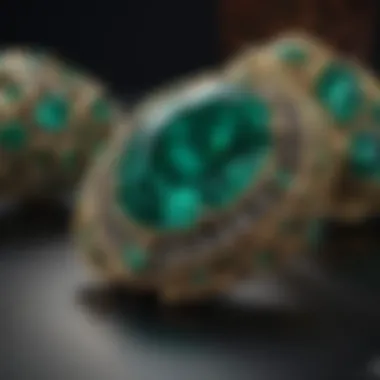
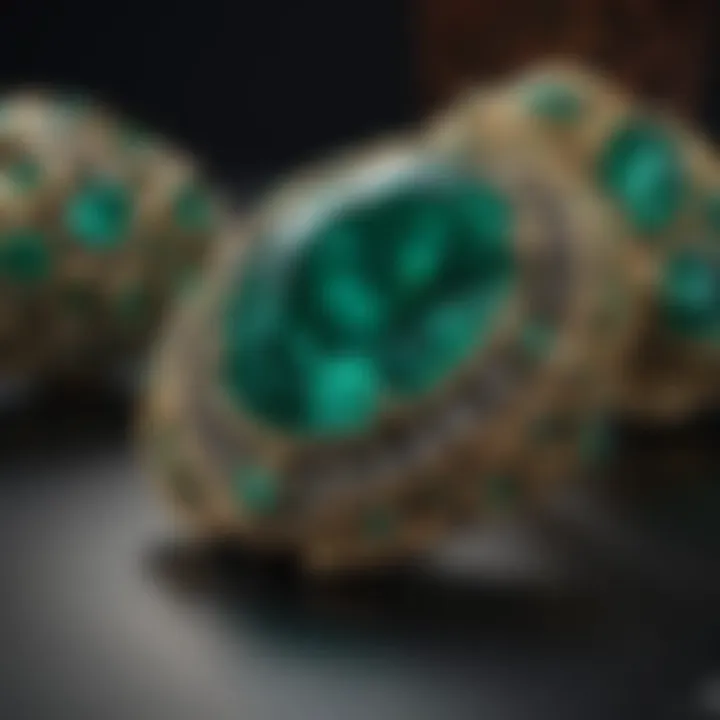
In summary, understanding birthstones encompasses a wide range of cultural, historical, and astrological dimensions. The significance of these gems varies by culture and individual belief, making their study a rich and rewarding journey.
The May Birthstone
The May birthstone is significant not only for people born in this month but also for those interested in gemstones in general. It is a clear representation of luxury, nature, and historical importance. The emerald, the birthstone for May, is tied to various cultural beliefs and has longstanding associations with prosperity and growth. Understanding this gemstone provides insight into its multifaceted role in history, relationships, and more.
Emerald: The Birthstone of May
Emeralds are known for their lush green color and have captivated humanity for centuries. They are part of the beryl family, which adds to their allure. The emerald’s significance goes beyond its beauty, representing balance and harmony. When one thinks of the May birthstone, it is clear that emeralds are not just mere stones; they are symbols of renewal and fertility.
Significance of Emeralds
Emeralds are deeply rooted in history and culture. They have been treasured by civilizations such as the Egyptians and Romans, who believed in their strong protective energies. The stone is often associated with the wellbeing of the mind and the body. In addition, emeralds are said to inspire loyalty and enhance love, making them popular as engagement ring stones.
The Emerald's Color and Quality
The color and quality of emeralds play a crucial role in their overall appeal and value. A few key aspects guide the evaluation of an emerald, such as color variations, clarity, and cut.
Color Variations
Emeralds primarily exhibit a vivid green hue, but there are variations within this spectrum. The quality of the color is essential when assessing an emerald. The most sought-after emeralds are those with a deep green color that displays brightness and saturation. In terms of specific aspects, the pure and rich colors are not only a visual delight but also a sign of higher value.
Additionally, the presence of secondary hues, such as blue or yellow, can affect desirability. These variations can make certain emeralds more distinctive but may also water down their value under specific circumstances. Therefore, consumers should be aware of these color variations when purchasing.
Clarity and Transparency
Clarity and transparency are significant when considering an emerald's overall quality. Unlike diamonds, emeralds usually contain inclusions, but these inclusions can enhance their uniqueness. However, excessive inclusions can detract from an emerald's beauty.
Ultimately, clarity affects the transparency of the stone. High-quality emeralds display a clear appearance without cloudiness, making them more valuable. A balance is often sought: some inclusions add character, while clarity impacts overall desirability.
Cut and Shape
The cut and shape of an emerald are critical to its brilliance and aesthetic appeal. It directly influences how light interacts with the stone. Various cuts, including rectangular and oval, are popular choices. The cut determines not just the light reflection but also how the stone sits in a piece of jewelry.
Naturally, a well-cut emerald showcases its inherent beauty, while a poorly cut one may hinder its appeal, regardless of its color or clarity. Therefore, when selecting emeralds, evaluating the cut is as important as color and clarity.
In summary, the May birthstone, emeralds, are multifaceted gems defined by their rich symbolism and beauty. Understanding the importance of color, clarity, and cut offers valuable insight for gemstone enthusiasts and collectors alike.
The Metaphysical Properties of Emeralds
Emeralds, often associated with various mystical and metaphysical attributes, hold a significant place in both history and modern practices. Understanding the metaphysical properties of emeralds is essential for enthusiasts and those who value gemstones not just for their beauty but also for their deeper meanings. These qualities can encompass themes of renewal, love, and protection, making emeralds a popular choice in both personal and ceremonial contexts.
Meaning and Symbolism
Emeralds symbolize hope, love, and renewal. Across cultures, they have been considered powerful stones that can foster a sense of peace and harmony. In ancient civilizations, such as the Egyptians, emeralds were believed to represent fertility and rebirth, and they were often buried with the dead to ensure a safe passage to the afterlife. The green color of the emerald speaks to the vibrancy of life, representing growth and transformation.
In contemporary spiritual practices, emeralds are often associated with the heart chakra. This connection signifies emotional healing and communication, enhancing one's ability to deal with matters of the heart. Therefore, individuals seeking to cultivate love and understanding may find emeralds to be particularly beneficial.
"Emeralds are more than just beautiful gems; they embody a rich tapestry of meaning and significance rooted in various traditions and beliefs."
Healing Properties
Emeralds are also thought to possess several healing properties. Many practitioners in the field of alternative medicine value these stones for their potential to heal emotional ailments. They are believed to aid in releasing negativity, as well as promoting emotional stability. This healing energy may work to alleviate feelings of fear or uncertainty, bringing clarity and focus to one's thoughts.
In addition, emeralds are reputed to help with physical healing, particularly in matters related to the heart and lungs. Some people also use emeralds to relieve digestive issues and promote overall bodily healing. The stone’s green hue is thought to encourage rejuvenation, vitality, and recovery from illness.
Emeralds in Meditation and Practice
Using emeralds in meditation is a common practice among energy workers and spiritual seekers. Holding or placing an emerald during meditation can enhance one’s connection to the heart chakra. This allows individuals to focus on emotional healing and promotes a sense of balance and tranquility.
Emeralds can also help in deepening intuition and spiritual awareness. When incorporated into rituals or daily practices, they serve as tools for grounding and enhancing meditative experiences. Practitioners often report a heightened sense of peace and clarity when working with emeralds.
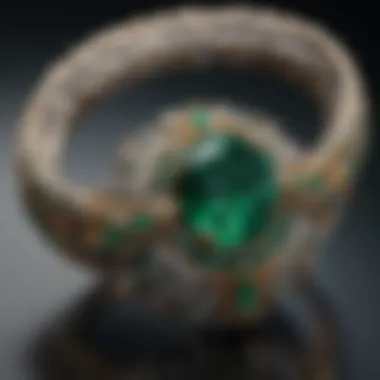
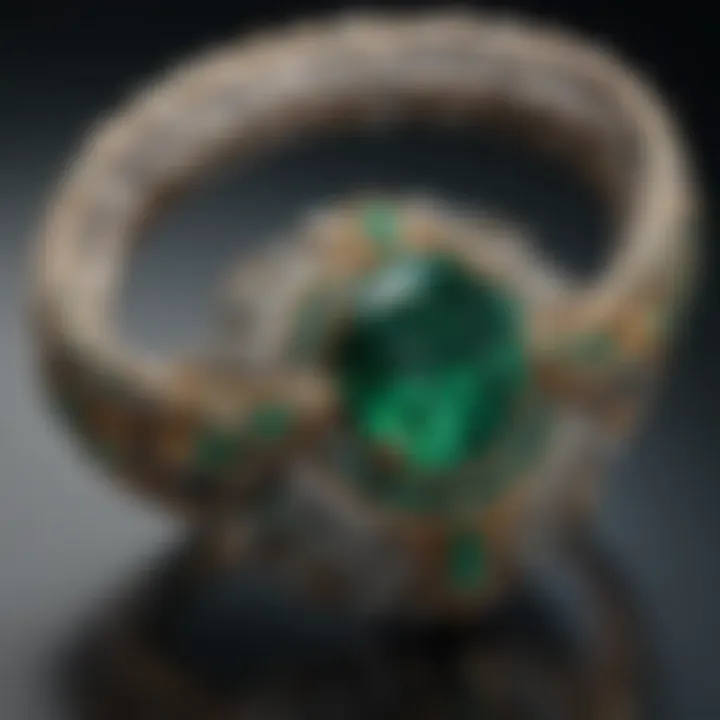
The Role of Emeralds in Jewelry
Emeralds play a significant role in the realm of jewelry due to their unique beauty, rarity, and rich history. They are more than mere adornments; emeralds represent a blend of culture, craftsmanship, and personal expression. The allure of emeralds is evident in their enduring popularity and their esteemed place in both historical artifacts and modern designs.
Emeralds in Historical Artifacts
Historically, emeralds have adorned the crowns and jewelry of royals and leaders across various civilizations. Ancient Egyptians believed that emeralds symbolized fertility and rebirth, often associating them with the goddess Isis. The significance of these gemstones persisted through time, influencing the jewelry of the Byzantine Empire and beyond.
Notable artifacts, such as the crown jewels of different monarchies, showcase emeralds as symbols of power and wealth. These historical pieces provide valuable insights into the aesthetic preferences and cultural values of past societies. They highlight how emeralds have transcended time, maintaining their status as desirable gems.
Modern Jewelry Trends
In today's market, emeralds continue to be at the forefront of jewelry trends. Jewelry designers are increasingly incorporating emeralds into contemporary pieces, benefiting from their captivating green hues and their association with elegance and sophistication. These gems are featured in various forms, including rings, necklaces, and earrings, often set in gold or white gold to enhance their color.
Emeralds are also popular in customized jewelry, allowing individuals to express personal style while investing in something unique and memorable. The shift towards sustainable and ethically sourced materials is influencing modern trends, causing a rise in demand for responsibly mined emeralds.
Choosing the Right Emerald Jewelry
Choosing emerald jewelry involves several important considerations.
Design Considerations
The design of emerald jewelry can greatly influence its overall appeal. A thoughtful design accentuates the stone’s color and brilliance, drawing the eye and highlighting its natural beauty. Popular designs range from classic to contemporary styles. For instance, vintage-inspired pieces often feature intricate settings that echo historical trends, while minimalist styles favor a more modern, sleek appearance.
Setting Types
The setting type is crucial when selecting emerald jewelry. Prong settings, for example, elevate the stone, allowing light to penetrate and enhance its vibrant green color. Conversely, bezel settings offer durability and protection, which is particularly beneficial since emeralds are relatively softer than other gemstones. Each setting choice affects how the emerald’s beauty is displayed, making it essential to understand their advantages and disadvantages.
Custom vs. Mass-Produced
When considering jewelry, the decision between custom and mass-produced pieces carries weight. Custom jewelry offers uniqueness, tailored to individual preferences. This option can incorporate personal stories or specific design wishes, fostering a deeper emotional connection.
Mass-produced emerald jewelry is often more accessible and can feature trendy designs at a lower price point. However, the lack of uniqueness may lead to a less personal experience. Individuals must weigh the benefits of exclusivity against budgetary constraints.
"Emeralds have captivated through the centuries, revealing not just beauty but also deep cultural significance and personal meaning."
In summary, emeralds are invaluable in today’s jewelry landscape. Their historical relevance, modern trends, and careful selection processes create a vibrant narrative around these beautiful gems, appealing to both gem enthusiasts and casual buyers.
Caring for Emeralds
Caring for emeralds is a crucial aspect of ownership that enhances both the longevity and beauty of this precious gemstone. Emeralds, as the birthstone for May, are coveted not only for their deep green hue but also for their historical significance. Proper care ensures that the stone maintains its luster and quality over time, making it an enduring part of any jewelry collection.
Cleaning Methods
To keep emeralds looking their best, careful cleaning methods should be applied. Here are some effective techniques:
- Use lukewarm soapy water: A gentle soap solution is often sufficient. Avoid harsh chemicals that might damage the stone.
- Soft brushes: Utilize a soft toothbrush or a gentle cloth to remove dirt. This helps to maintain the clarity of the stone.
- Rinse and dry: Always rinse the emerald under clean, lukewarm water and pat dry with a soft cloth, ensuring no moisture remains to prevent buildup.
"Emeralds are more porous compared to other gemstones, making gentle cleaning essential to preserve their beauty."
Regularly cleaning emeralds not only preserves their appearance but also reinforces the bond between the wearer and the gemstone.
Storage Recommendations
When it comes to storage, emeralds need special care. Proper storage can prevent scratches and significant damage. Consider these recommendations:
- Separate compartments: Store emerald jewelry separately from other pieces to avoid scratches and tangles.
- Use soft pouches or cases: Fabric-lined pouches are preferable as they cushion the gems and reduce friction.
- Avoid excessive heat: Keep emeralds away from direct sunlight or extreme temperatures to prevent fading or cracking, which can occur if the gemstones have been treated.
Choosing the right storage method plays a significant role in maintaining the integrity of the stones over time.
Handling and Wear

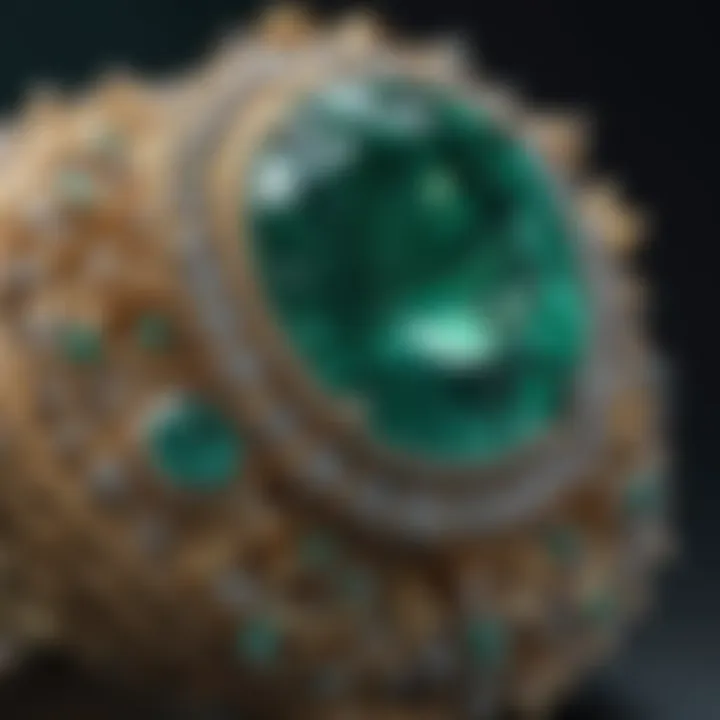
Emeralds require careful handling during wear. Since they can be brittle, proper precautions are essential. Here are some guidelines:
- Limit exposure to harsh environments: Avoid wearing emeralds in rough settings like beaches or while exercising, where they might get scratched or damaged.
- Regular inspection: Periodically check the settings and stones to ensure they are secure. This can prevent lost or damaged stones.
- Handle with clean hands: Oils and dirt from fingers can dull the stone’s surface, so it's best to handle emerald jewelry after washing hands.
In summary, caring for emeralds involves thoughtful cleaning, appropriate storage, and cautious handling. By being diligent in these areas, gemstone enthusiasts and jewelry collectors can enjoy the timeless beauty of emeralds for years to come.
Investment Potential of Emeralds
Emeralds are not just beautiful gemstones; they also hold significant potential as investment assets. This section explores the factors that contribute to the investment attractiveness of emeralds, providing insights for collectors and investors alike. Investing in emeralds offers a unique way to diversify one's portfolio. Unlike traditional investments in stocks or bonds, physical assets like emeralds can retain value and even appreciate over time.
The growing interest in colored gemstones, particularly emeralds, is driven by several considerations, including rarity, market demand, and cultural significance. Understanding these elements can inform potential investors about the advantages and risks associated with emerald investment.
Market Trends for Emeralds
The current market trends for emeralds reflect both a stable demand and a steady increase in value. In recent years, there has been a noticeable shift towards the appreciation of colored gemstones, with emeralds standing out prominently. According to various industry reports, the demand for high-quality emeralds continues to rise globally, driven by affluent buyers and collectors.
Factors contributing to this trend include:
- Increased accessibility through online marketplaces.
- Greater visibility in high-profile celebrity engagements and red carpet events.
- A surge in interest from younger generations looking for unique investments.
The prices of emeralds fluctuate based on market conditions, but high-quality emeralds have shown resilience even during economic downturns. Collectors often seek emeralds for both aesthetic enjoyment and potential long-term appreciation.
Factors Affecting Value
Several distinct factors influence the value of emeralds. Investors should consider the following:
- Origin: Emeralds from Colombia, known for their exceptional quality, often command higher prices. Other notable sources include Brazil and Zambia.
- Color Quality: The most desirable emeralds exhibit a rich green hue. Color saturation and tone are critical in determining value.
- Clarity: Unlike diamonds, emeralds often contain inclusions. However, less visible inclusions can significantly boost the emerald's worth.
- Carat Weight: Larger stones are rarer and thus generally have a higher value. However, balance with other quality factors is essential.
Taking these factors into account can guide potential investors in making informed decisions about purchasing emeralds.
Evaluating Authenticity
Authenticity is paramount in the emerald market. The presence of lab-created stones or treated emeralds can lead to misleading valuations. To ensure authenticity, consider the following:
- Gemological Certification: Seek gems certified by reputable organizations like the Gemological Institute of America (GIA). A certification provides assurance of the emerald’s quality and authenticity.
- Reputation of Dealer: Acquire emeralds from established jewelers or certified dealers who possess a good market reputation.
- Visual Inspection: Inspect the gem for color, clarity, and cuts. Authentic emeralds might show signs of unique inclusions, which are considered part of their character.
Emeralds, with their deep history and timeless appeal, represent a fascinating aspect of gemstone investment. By understanding market trends, value factors, and authenticity evaluation, investors can navigate the complexities of investing in emeralds effectively.
Final Thoughts on May and Its Birthstone
As we conclude our exploration of the birthstone associated with May 6, it is vital to understand the overarching significance of this topic. Birthstones typically hold profound meaning, often tied to personality traits, historical contexts, and cultural heritage. The emerald, specifically the birthstone for May, exemplifies these aspects with its rich history and vibrant symbolism. Not only does it attract gemstone enthusiasts, but it also captivates collectors and jewelry designers alike. Recognizing the attributes of emeralds allows individuals to appreciate their value better and consider how these gems align with personal identities.
Reflection on Birthstones
Birthstones serve as deeply personal symbols, acting not only as adornments but also as conduits of meaning. Each month holds a unique stone, often linked to astrological beliefs and historical significance. As a result, birthstones like the emerald enable people to embrace their birth month’s essence.
Emeralds, with their lush green hue, symbolize renewal and growth. This idea resonates strongly during the spring season, especially in May. Beyond basic aesthetics, many individuals find comfort in wearing stones believed to align with their personality or life events. Furthermore, understanding the historical use of emeralds—from ancient civilizations valuing them for their protective properties to the modern perception of their luxury—reinforces the timelessness of birthstones as a concept.
Emeralds: A Timeless Gem
Emeralds designated for May are not only visually stunning but also rich in history. The gemstone has featured prominently in various cultures throughout time. For example, Cleopatra was known for her love for emeralds, which were believed to enhance fertility and promote eloquence. This attribute of fertility is just one of many meanings associated with emeralds, reflecting their nature as timeless gems.
- Historical Prominence: Across different eras, emeralds have appeared in royal crowns and exquisite jewelry.
- Cultural Value: In many traditions, emeralds are associated with love and rebirth, offering strength and clarity to those who wear them.
Today, emeralds are still considered a status symbol among affluent circles, making them a pivotal aspect of luxury jewelry markets. Their rarity and deep color contribute to their lasting popularity.
Connecting with Personal Significance
The idea of personal significance tied to birthstones reflects an innate human desire to find meaning in life’s experiences. For many, wearing an emerald is more than an accessory; it is a personal emblem shaped by individual stories, milestones, and aspirations.
People may choose emeralds for various reasons—some due to their birth month, while others are drawn by their aesthetic appeal or perceived virtues. Regardless of the motivation, connecting with a birthstone entails discovering its implications in one's life.
Incorporating emeralds into daily life may strengthen one’s identity or serve as a reminder of personal journeys and growth. They can symbolize hope, rejuvenation, and love, serving as a beautiful reminder of an individual’s unique path in life.
"The emerald is not just a stone, it embodies personal connections and stories. Its deep green hue is a reflection of our most cherished experiences."
Ultimately, understanding the significance of emeralds and other birthstones fosters a deeper appreciation for not only the stones themselves, but also the individual narratives they represent.



